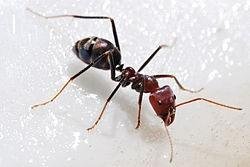Ant
Fossil Range: Cretaceous Period - Now
Meat eater ant feeding on honey02.jpg
Ants are eating honey
Scientific classification
Kingdom: Animalia
Phylum: Artropoda
Class: Insects
Order: Hymenoptera
Suborder: Apokrita
Superfamily: Vespoidea
Family: Formicidae
Latreille, 1809
Anaksuku
Aenictogitoninae
Agroecomyrmecinae
Amblyoponinae (including "Apomyrminae")
Aneuretinae
Cerapachyinae
Dolichoderinae
Ecitoninae (including "Dorylinae" and "Aenictinae")
Ectatomminae
Formicinae
Heteroponerinae
Leptanillinae
Leptanilloidinae
Myrmeciinae (including "Nothomyrmeciinae")
Myrmicinae
Paraponerinae
Ponerinae
Proceratiinae
Pseudomyrmecinae
Ants are all insects of the members of the tribe of Formicidae, the Hymenoptera. Ants have more than 12,000 species (species), mostly living in the tropics. Most of the ants are known as social insects, with their colonies and regular nests consisting of thousands of ants per colony. Members of the colony are divided into worker ants, male ants, and queen ants. There may also be a group of guard ants. One colony can dominate a large area to support their lives. Ant colonies are sometimes called "superorganisms" because of their colonies that form a unity. 
Despite its relatively small size, the ants are among the strongest animals in the world. Male ants are able to sustain loads weighing fifty times their own body weight, comparable to elephants that are only able to sustain loads weighing twice the weight of their own body. Ants are rivaled only by rhinoceros beetles capable of sustaining loads weighing 850 times their own body weight.
Hi! I am a robot. I just upvoted you! I found similar content that readers might be interested in:
https://play.google.com/store/apps/details?id=com.theantapp.UrduApps
Downvoting a post can decrease pending rewards and make it less visible. Common reasons:
Submit